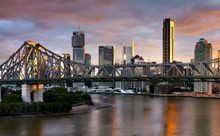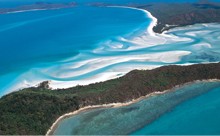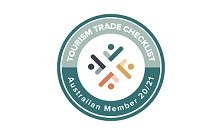Cairns
The gateway to tropical northern Australia,Cairns is renowned for its World Heritage Listed sites - The Great Barrier Reef and the Rainforest. Here you can enjoy water sports such as snorkelling, diving, and sailing on the Great Barrier Reef, go white water rafting in the on the Barron or Tully rapids, explore the lush tropical rainforests, and experience the ancient indigenous Aboriginal culture. Cairnsis a smaller city with a relaxed lifestyle and has a variety of services that cater for tourists including restaurants, shops, and a choice of accommodation options.
Climate
Australia is located in the Southern Hemisphere and the seasons in Cairns occur in the opposite order to those countries located in the Northern hemisphere. Summer is from December to February, autumn from March to May, winter from June to August, and spring from September to November.
Cairns has a tropical rainforest climate with a wet season from November to April and a dry season from May to October. During the wet season the weather is hot and humid with tropical storms and heavy rain occurring, while the dry season from May to October is cooler with mild weather and clear sunny days. The month of July is the coolest time of the year (average daily temperature of 20 degrees) and it is recommended to bring a light jacket during the dry season as evenings and early mornings can be cool.
|
December to February |
December to April is summer in Cairns and also the wet season. During this time the region experiences hot days with high humidity and heavy rainfalls begin to occur during February. The average daytime temperature during summer is approximately 31-32℃, while nights average 22℃. |
|
March to May |
March and April is still the wet season in Cairns with heavy rain periods and an average day time temperature of 26-29℃, while nights average 21℃. In May the dry season begins with lower rainfalls and temperatures averaging 27℃ during the day and approximately 19℃ at night. |
|
June to August |
June to August is the dry season in Cairns and the region experiences mild temperatures with very little rain. Daytime temperatures reach approximately 26℃, while night time are cooler and with an average of 18℃. |
|
September to November |
The dry season continues during September and November and this time of year is very comfortable with average daily temperatures of 29℃, and nights averaging 19-22℃. |
Average annual temperature comparisons
|
CITY |
JAN |
FEB |
MAR |
APR |
MAY |
JUN |
JUL |
AUG |
SEP |
OCT |
NOV |
DEC |
|
|
Cairns |
Max (℃) |
32 |
31 |
31 |
29 |
28 |
26 |
26 |
27 |
28 |
29 |
31 |
31 |
|
Rain (millimetres) |
405 |
434 |
424 |
198 |
100 |
49 |
30 |
27 |
35 |
38 |
89 |
176 |
|
Clothing
Casual lightweight clothes are the best option when visiting Cairns. It is also recommended to bring a light jacket to wear as temperatures can become cool in the evenings and early mornings, especially in the rainforest areas, and air conditioning on buses and in hotel rooms can be cold. During the wet season heavy rain and tropical storms occur, so it is recommended to pack rain gear if you are planning to travel to Cairns during this time.
As the Australian sun has very high UV (ultra violet) light levels, travellers should bring sun protection for all seasons. This includes SPF 30+ sunscreen, a broad brimmed hat, collared long sleeved shirt, and sunglasses.
At restaurants and bars it is recommended to wear smart casual attire as customers may be refused entry when wearing singlets, shorts, and sandals. If you are planning to dine at a hotel or fine dining restaurant then smart evening attire is recommended.
Time difference
Cairns is in the Australian Eastern Standard Time (AEST) zone, which is Coordinated Universal Time plus 10 hours (UMT+10). Daylight savings is not observed in Cairns.
|
Capital City Time Differences |
Normal |
Daylight Savings |
|
Sydney |
09:00am |
10:00am |
|
Cairns, Brisbane, Gold Coast |
09:00am |
09:00am |
|
Melbourne |
09:00am |
10:00am |
|
Hobart |
09:00am |
10:00am |
|
Adelaide |
08:30am |
09:30am |
|
Darwin |
08:30am |
09:30am |
|
Perth |
07:00am |
07:00am |
Australian Currency
The currency used in Australia is the Australian Dollar (AUD). Coins have values of 5 cents, 10 cents, 20 cents, 50 cents, $1.00, and $2.00 AUD, while note values are $5, $10, $20, $50, and $100 AUD. Currency exchange is available at banks, foreign exchange bureaus, and international airports.
Goods and Services Tax (GST)
Australia has a 10% goods and services tax (GST) charged on the supply of most goods and services.
Payment options in Australia
Credit cards are widely accepted in Australia and it is recommended to use an international credit card combined with cash in Australian Dollars (AUD), rather than carrying large amounts of cash only. The most commonly accepted credit cards are Visa and MasterCard. Some service providers, such as restaurants and hotels, may charge a credit card surcharge or have a minimum spend amount on purchases that are paid for by credit card, or they may accept cash payments only.
Traveller with a credit card
- Combine the use of an international credit card with cash in Australian Dollars (AUD).
- It is recommended to bring cash in Australian Dollars (AUD) as some service providers, such as restaurants and hotels, may charge a credit card surcharge or have a minimum spend amount on purchases that are paid for by credit card, or they may accept cash payments only.
Traveller without credit card
- Travellers without a credit card should avoid carrying large amounts of cash around, it is safer to carry small amounts and store remaining cash in the hotel safe. Another option is to use Australian dollar (AUD) traveller’s cheques, which can be exchanged at banks, foreign exchange bureaus, and some hotels, or use a foreign currency travel card in Australian Dollars (AUD).
SKYhub and OPT will accept customer payments for optional tours by travellers cheques. However please be aware that most service providers and shops do not accept payment by traveller’s cheques, and customers will need to exchange their traveller’s cheques to cash at a bank or foreign currency exchange bureau (fees may apply).
Electricity
Australian electrical voltage is 220 to 240V, AC50Hz. It is recommended to bring a power adapter with the below flat pin plugs for use during your stay, and to also check if your electrical items can be used with a 240V power supply or if they require a voltage converter to operate or charge.
Electrical items should be charged before being packed with your luggage. Most hotels in Australiahave hairdryers in guest rooms.
Baggage
When packing for your trip it is important not to exceed the checked baggage allowances set by the airline and to leave spare room in your suitcase for shopping and souvenirs. All airlines have strict baggage allowances, and if the weight or dimensions of your luggage is greater than the allowance set by the airline then excess baggage charges are usually incurred at check in, or the airline may refuse to carry the excess baggage.
Baggage Limits
- Qantas economy class - 23kg checked luggage & 7kg carry on;
- Jetstar economy – checked and carry on luggage allowance will depend on fare selected.
For other airlines, please refer to the baggage allowances information on their website or ask your travel agent for details.
Liquids, Aerosols, and Gel restrictions on Flights
For international flights arriving and departing fromAustralia, including the domestic leg of an international flight, there are restrictions that apply to the amount of liquids, aerosols, and gels (including duty free) that passengers can take in their carry on luggage.
- Liquid, aerosol, or gel products have to be in containers of 100ml or less.
- The containers must be carried a transparent plastic bag.
- The size of the plastic bag is not to exceed 20cm x 20cm
- The plastic bag needs to be a resealable type (sandwich or freezer bag type)
- One bag permitted per passenger, with the exception of carers who are permitted to carry the bag of the person they are caring for.
- All containers have to fit easily into the plastic bag and the bag is required to be sealed
- The bag is to be presented separately to other carry on items when going through the airport security screening point.
If items are greater than 100ml they will need to be packed as checked baggage as they will not be allowed through the security screening point. These restrictions are subject to change and for further information please refer to your airlines website or ask your travel agent for details.
Duty Free
Travellers who are visiting from overseas or returning home are permitted duty free limits on Alcohol, general goods, and tobacco products. These limits apply to goods that are brought into Australia in a travelers carry on or checked baggage, that have been purchased overseas or at an arrival duty free store before clearing Australian customs, previously been exported and purchased tax or duty free in Australia, or have had a claim made through the Travellers Refund Scheme.
Alcohol – each inbound traveler aged 18 years and over is permitted to enterAustralia with 2.25 liters of alcoholic beverages (champagne, wine, and liquor).
General Goods – each inbound traveller aged 18 years and over is allowed to enterAustralia with A$900 worth of goods, while inbound travellers who are under 18 years of age are permitted a limit of A$450. Items that are classed as general goods include cameras, electronic equipment, souvenirs, leather goods, perfume concentrates, sporting equipment, jewellery, and watches.
Tobacco products – Inbound travellers aged 18 years and over are each permitted to bring 50 cigarettes or 50 grams of cigars or tobacco products intoAustralia duty free.
If a traveller exceeds the duty free limits they will be charged duty and tax on all items of that type (alcohol, general goods, tobacco products) and not just on the item that exceeds the limit. Please note the above duty free limits are subject to change.
Tourist Refund Scheme (TRS)
The Tourist Refund Scheme (TRS) allows departing travellers to claim a refund for the GST (goods and services tax) and WET (wine equalisation tax) that has been paid on goods which were purchased inAustralia.
To be able to claim a refund the goods must total A$300 or more (GST inclusive), have been purchased at the same store, be listed on a single tax invoice, and have been purchased no more than 30 days before departure. Refunds only apply to goods that are worn or taken as carry on luggage onto the aircraft or ship (liquid, aerosol, and gel security restrictions still apply).
Claims can be made at a TRS facility after clearing customs and immigration, and the goods along with the original tax invoice, your passport, and international boarding pass are to be presented to the customs officer at the TRS facility. Claims can be made up to 30 minutes prior to the scheduled departure of your flight.
Public Holidays
|
New Years Day |
01 January 2013 |
|
Australia Day |
28 January 2013 |
|
Good Friday |
29 March 2013 |
|
Easter Saturday |
30 March 2013 |
|
Easter Monday |
01 April 2013 |
|
ANZAC Day |
25 April 2013 |
|
Labour Day |
06 May 2013 |
|
Cairns Show Day |
20 July 2012 |
|
Queens Birthday |
1st weekend in October |
|
Christmas Day |
25 December 2012 & 2013 |
|
Boxing Day |
26 December 2012 & 2013 |



